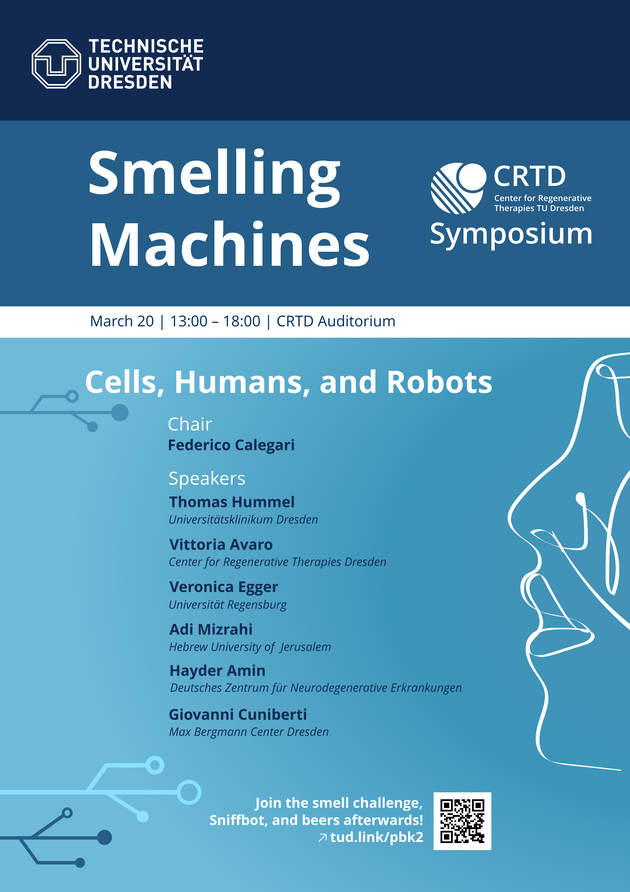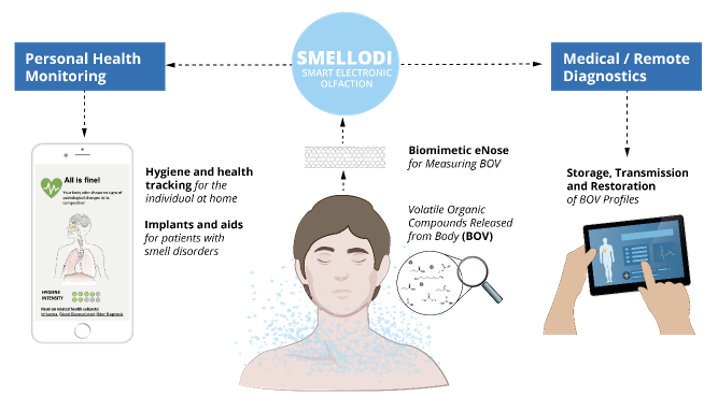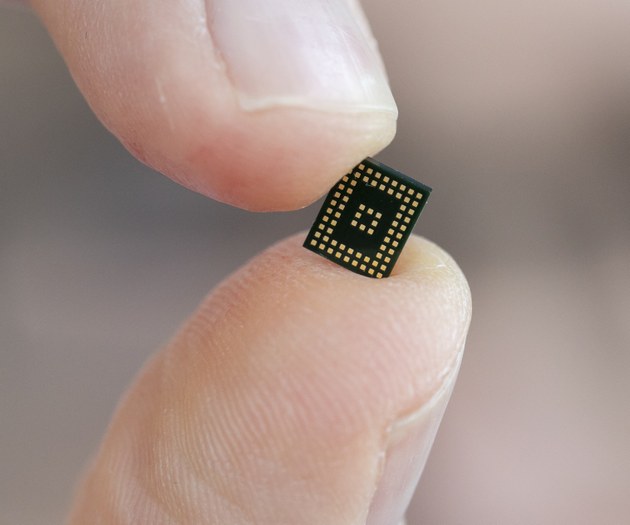
Research groups are preparing autonomous flying swarms for the forest and founding start-ups.

By Stephan Schön
Dresden. With a lot of computer science and drones, Dresden researchers want to save the endangered forest. They are working on autonomous swarms that detect two of the biggest threats to Saxony's forests: bark beetles and fire. This is reported by Uwe Aßmann, professor of
While two start-ups are already being set up for the forest fire drones, the bark beetle sniffer is still in the research phase. However, it should also be working in two years and lead to the founding of a company. “Dresden has all the essential components for this,” says Aßmann. The Dresden researchers have experience with olfactory sensors. The Sniffbot olfactory robot for use in the event of a disaster or chemical accident has already been developed and built.
Gianaurelio Cuniberti, a professor of materials science and nanotechnology, and his team have created the sensors for it. The research team can produce sensors that react to a very specific odor molecule as nanotubes with a diameter of just five millionths of a The goal now is to build sensors that can sniff out the first bark beetles from a distance. These first bark beetles emit scents to attract entire swarms of the pests. If the danger is detected very early, the forest still has a chance against it. Instead of individually searching every tree for such traces, drones will fly over and explore large forest areas in a short time.
The high-tech companies in the process of being founded, Trid and Smarobix, are working on a forest fire concept. Here, swarms of drones are to find embers in large areas and regions that are difficult to access, says Robert Rathmann of Trid. From a height of 120 meters, the drone's sensors can detect a burning candle in a fast fly Smarobix, another spin-off from the TU research, can provide the necessary acceleration of the microchips. Large amounts of data have to be processed in the drones during the flight and a long flight time is also necessary, explains Johannes Mey. His spin-off provides a new software tool for this.
In the future, there will be a unique facility in Germany for flight testing The TU's Smart Mobility Lab is currently being built in Hoyerswerda, with a large test hall. It should be ready for use from 2027. The same goes for Europe's largest test flight field for autonomous flying, which extends from Hoyerswerda via Kamenz to Görlitz and Weißwasser. There is also enough space for forest fire detectors and bark beetle sniff.
Original Version:
Dresdner Drohnen sollen Borkenkäfer riechen und Waldbrände finden
Forschungsgruppen bereiten für den Wald autonome Flug-Schwärme vor und gründen Start-ups.
Translated with deepL.com
Von Stephan Schön
Dresden. Mit viel Informatik und Drohnen wollen Dresdner Forscher den gefährdeten Wald retten. Sie arbeiten an autonomen Schwärmen, die zwei der größten Bedrohungen für sächsische Wälder aufspüren: Borkenkäfer und Feuer. Das berichtet Uwe Aßmann, Professor für Softwaretechnologie an der TU Dresden, der SZ.
Während bei den Waldbrand-Drohnen bereits zwei Start-ups in Gründung sind, befindet sich der Borkenkäfer-Schnüffler noch in der Forschung. Der soll aber ebenfalls in zwei Jahren funktionieren und eine Firmengründung bringen. „Alle wesentlichen Komponenten dafür hat Dresden zu bieten“, sagt Aßmann. Mit Riechsensoren haben die Dresdner Forscher Erfahrung. Der Riech-Roboter Sniffbot für den Katastrophenfall und bei Chemieunfällen wurde bereits entwickelt und gebaut.
Gianaurelio Cuniberti mit seinem Team, er ist Professor für Materialwissenschaft und Nanotechnik, hat dafür die Sensoren geschaffen. Sensoren, die auf ein ganz bestimmtes Geruchsmolekül reagieren, kann das Forschungsteam als Nanotubes mit nur fünf Millionstel Millimetern Durchmesser herstellen. Ziel ist es nun, Sensoren zu bauen, die die ersten Borkenkäfer aus der Ferne erschnüffeln können. Diese ersten Borkenkäfer senden Duftstoffe aus, um damit ganze Schwärme der Schädlinge anzulocken. Wird sehr zeitig die Gefahr erkannt, hätte der Forst noch eine Chance dagegen. Statt individuell jeden Baum nach solchen Spuren abzusuchen, sollen Drohnen große Waldgebiete dafür in kurzer Zeit überfliegen und erkunden.
Die Hightech-Firmen in Gründung, Trid und Smarobix, arbeiten indes am Waldbrandkonzept. Hier sollen Schwärme von Drohnen in großen Gebieten und schwer zugänglichen Regionen Glutnester finden, sagt Robert Rathmann von Trid. Aus 120 Metern Höhe können die Sensoren der Drohne im schnellen Überflug eine brennende Kerze erkennen. Die dafür nötige Beschleunigung der Mikrochips kann Smarobix bieten, ebenfalls eine Ausgründung aus der TU-Forschung. Große Datenmengen müssten beim Flug in den Drohnen verarbeitet werden und eine lange Flugzeit sei zudem nötig, erklärt Johannes Mey. Seine Ausgründung liefere ein neuartiges Software-Werkzeug dafür.
Für die Flugerprobung gibt es künftig eine deutschlandweit einmalige Einrichtung. Das Smart Mobility Lab der TU entsteht derzeit in Hoyerswerda mit einer großen Testhalle. Ab 2027 soll sie nutzbar sein. Ebenso wie das europaweit größte Test-Flugfeld für autonomes Fliegen. Dieses reicht von Hoyerswerda über Kamenz bis Görlitz und Weißwasser. Genügend Platz auch für die Waldbrand-Sucher und Borkenkäfer-Schnüffler.








Research groups are preparing autonomous flying swarms for the forest and founding start-ups.

By Stephan Schön
Dresden. With a lot of computer science and drones, Dresden researchers want to save the endangered forest. They are working on autonomous swarms that detect two of the biggest threats to Saxony's forests: bark beetles and fire. This is reported by Uwe Aßmann, professor of
While two start-ups are already being set up for the forest fire drones, the bark beetle sniffer is still in the research phase. However, it should also be working in two years and lead to the founding of a company. “Dresden has all the essential components for this,” says Aßmann. The Dresden researchers have experience with olfactory sensors. The Sniffbot olfactory robot for use in the event of a disaster or chemical accident has already been developed and built.
Gianaurelio Cuniberti, a professor of materials science and nanotechnology, and his team have created the sensors for it. The research team can produce sensors that react to a very specific odor molecule as nanotubes with a diameter of just five millionths of a The goal now is to build sensors that can sniff out the first bark beetles from a distance. These first bark beetles emit scents to attract entire swarms of the pests. If the danger is detected very early, the forest still has a chance against it. Instead of individually searching every tree for such traces, drones will fly over and explore large forest areas in a short time.
The high-tech companies in the process of being founded, Trid and Smarobix, are working on a forest fire concept. Here, swarms of drones are to find embers in large areas and regions that are difficult to access, says Robert Rathmann of Trid. From a height of 120 meters, the drone's sensors can detect a burning candle in a fast fly Smarobix, another spin-off from the TU research, can provide the necessary acceleration of the microchips. Large amounts of data have to be processed in the drones during the flight and a long flight time is also necessary, explains Johannes Mey. His spin-off provides a new software tool for this.
In the future, there will be a unique facility in Germany for flight testing The TU's Smart Mobility Lab is currently being built in Hoyerswerda, with a large test hall. It should be ready for use from 2027. The same goes for Europe's largest test flight field for autonomous flying, which extends from Hoyerswerda via Kamenz to Görlitz and Weißwasser. There is also enough space for forest fire detectors and bark beetle sniff.
Original Version:
Dresdner Drohnen sollen Borkenkäfer riechen und Waldbrände finden
Forschungsgruppen bereiten für den Wald autonome Flug-Schwärme vor und gründen Start-ups.
Translated with deepL.com
Von Stephan Schön
Dresden. Mit viel Informatik und Drohnen wollen Dresdner Forscher den gefährdeten Wald retten. Sie arbeiten an autonomen Schwärmen, die zwei der größten Bedrohungen für sächsische Wälder aufspüren: Borkenkäfer und Feuer. Das berichtet Uwe Aßmann, Professor für Softwaretechnologie an der TU Dresden, der SZ.
Während bei den Waldbrand-Drohnen bereits zwei Start-ups in Gründung sind, befindet sich der Borkenkäfer-Schnüffler noch in der Forschung. Der soll aber ebenfalls in zwei Jahren funktionieren und eine Firmengründung bringen. „Alle wesentlichen Komponenten dafür hat Dresden zu bieten“, sagt Aßmann. Mit Riechsensoren haben die Dresdner Forscher Erfahrung. Der Riech-Roboter Sniffbot für den Katastrophenfall und bei Chemieunfällen wurde bereits entwickelt und gebaut.
Gianaurelio Cuniberti mit seinem Team, er ist Professor für Materialwissenschaft und Nanotechnik, hat dafür die Sensoren geschaffen. Sensoren, die auf ein ganz bestimmtes Geruchsmolekül reagieren, kann das Forschungsteam als Nanotubes mit nur fünf Millionstel Millimetern Durchmesser herstellen. Ziel ist es nun, Sensoren zu bauen, die die ersten Borkenkäfer aus der Ferne erschnüffeln können. Diese ersten Borkenkäfer senden Duftstoffe aus, um damit ganze Schwärme der Schädlinge anzulocken. Wird sehr zeitig die Gefahr erkannt, hätte der Forst noch eine Chance dagegen. Statt individuell jeden Baum nach solchen Spuren abzusuchen, sollen Drohnen große Waldgebiete dafür in kurzer Zeit überfliegen und erkunden.
Die Hightech-Firmen in Gründung, Trid und Smarobix, arbeiten indes am Waldbrandkonzept. Hier sollen Schwärme von Drohnen in großen Gebieten und schwer zugänglichen Regionen Glutnester finden, sagt Robert Rathmann von Trid. Aus 120 Metern Höhe können die Sensoren der Drohne im schnellen Überflug eine brennende Kerze erkennen. Die dafür nötige Beschleunigung der Mikrochips kann Smarobix bieten, ebenfalls eine Ausgründung aus der TU-Forschung. Große Datenmengen müssten beim Flug in den Drohnen verarbeitet werden und eine lange Flugzeit sei zudem nötig, erklärt Johannes Mey. Seine Ausgründung liefere ein neuartiges Software-Werkzeug dafür.
Für die Flugerprobung gibt es künftig eine deutschlandweit einmalige Einrichtung. Das Smart Mobility Lab der TU entsteht derzeit in Hoyerswerda mit einer großen Testhalle. Ab 2027 soll sie nutzbar sein. Ebenso wie das europaweit größte Test-Flugfeld für autonomes Fliegen. Dieses reicht von Hoyerswerda über Kamenz bis Görlitz und Weißwasser. Genügend Platz auch für die Waldbrand-Sucher und Borkenkäfer-Schnüffler.






